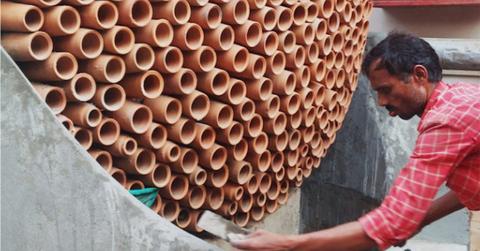This Artistic Air Conditioner Can Cool A House Without Using Any Electricity At All
With temperatures on the rise across the world, this new design for home cooling could be a solution for places with limited access to electricity.
Updated May 24 2019, 12:05 a.m. ET
An architecture firm called Ant Studio has partnered with company DEKI Electronics to create a cooling system that is electricity free. The installation is built into DEKI's factory, and arranges hundreds of cone-shaped terracotta tubes into a honeycomb-like circle. Inhabitat reports that when kept wet, consistent evaporation lowers the temperature in the building from about 122 degree Fahrenheit to about 96 degrees around the sculpture, 107 degrees atmospherically. That may sound pretty hot still, but the difference of those 13 degrees could be life and death for some.
And it's also a structure that could theoretically be built anywhere, even in remote locations that operate of a consistent electrical grid. While air conditioning feels delicious in summer, running contributes to the emissions damaging and heating the planet in the first place, creating a cycle on our dangerously heating planet. Ant Studio's founder, Monish Siripurapu, told Arch Daily that the architecture studio focuses on how their work impacts the environment, not just the skyline.
"As an architect, I wanted to find a solution that is ecological and artistic, and at the same time evolves traditional craft methods," he said.
The beauty of the installation is important, but don't let it's haphazard creative look fool you. All the measurements for designing the cylinders is extremely precise. Computational analysis was used to calibrate the thickness of the cones walls, in an attempt to get as much surface area as possible for evaporation to take place. However, the terracotta is inexpensive and easily replicated. It's still in the experimental stages, but Ant Studio is optimistic about what the findings could mean for further attempts, not just for the environment, but for the beauty of design.
“I believe this experiment worked quite well functionally. Findings from this attempt opened up a lot more possibilities where we can integrate this technique with forms that could redefine the way we look at cooling systems, a necessary yet ignored component of a building’s functionality. Every installation could be treated as an art piece," Siripurapu explained.
